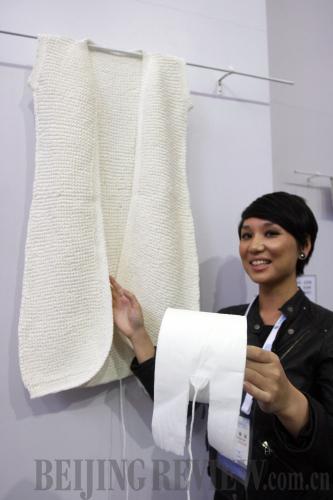|
Low carbon clothes
 |
|
ENERGY SAVING: A dress made of toilet paper is shown at an exhibition on new energy technologies in Beijing in 2009 (CHEN XIAOGEN) | Li-Ning announced last year that they would cooperate with Teijin Fibers Ltd. of Japan to produce eco-circle clothing.
The company said a kind of new technology would be used to crush synthetics used for clothing into fibers and then reuse those fibers to make new clothes. But in this way, the quality of the new clothes is not as good as the original. Technicians are now using eco-circle materials to make clothing and apply chemical methods to help the clothes decompose.
After chemical decomposition, old clothes are converted into raw material for polyester, the purity of which is comparable to that derived from petroleum. The material is then turned into high-quality eco-circle fiber, which is then used to manufacture new, recyclable products, said Fang Shiwei, Li-Ning's Vice President.
Repeated recycling achieved by the eco-circle system reduces both energy consumption and carbon dioxide emissions by approximately 80 percent, compared to conventional petroleum-based processes used to produce polyester, Fang said.
Li-Ning has also developed a line-up of sports gear using Teijin Fibers' chemically recycled eco-circle fibers, oriented to Chinese consumers between 18 and 30, with special emphasis on both fashion and comfort. Fang said clothes made from eco-circle materials would be labeled accordingly.
"By utilizing high technology, the clothes are made of recycled materials, which effectively reduces their carbon emissions," said Lin Songen, a brand manager for Li-Ning.
Li-Ning also plans to open 50 outlets during the next year all over China to provide recycling services.
"Theoretically, the eco-circle system is suitable for producing all kinds of synthetic fibers so it provides a wide-range of choice to China's whole textile and apparel industry, and will make a substantial contribution to industry environmental protection moves," said Wu Xuexian, Director of Li-Ning's Apparel Research and Development Department.
Low carbon concepts were first introduced to the apparel industry five years ago. But only over the past couple of years have they gradually attracted greater attention.
At the end of 2007, an application from import and export industries was tabled at the Hong Kong office of the World Wildlife Fund. Overseas buyers requested Chinese manufacturers provide detailed reports about greenhouse gas emissions of each product. The event finally led to the birth of the Low Carbon Manufacturing Program (LCMP) in China.
In September 2008, Hong Kong Lever Style Incorporation became the first trial subject of the LCMP. It cost 3 million yuan ($439,000) to develop the necessary technological innovation. But the company then saved approximately 2.8 million yuan ($410,000) in resources and material consumption within a year.
"Although there is still no clear requirement about the emission reductions of the textile and apparel industry, the low carbon trend has attracted attention from many apparel enterprises," said James Hong, General Manager of Zuoan Garments Co., Ltd.
"Each apparel enterprise has its own appropriate low carbon method and the key to success lies in its choice of strategy," said Fashion Times, a magazine jointly published by the Economic Daily, China National Garments Group and the Beijing Clothing and Textile Trade Association.
There are three low carbon strategies for most apparel enterprises—saving energy and reducing emissions, using new energies, and developing carbon-capture technology, the magazine said. But at the moment, saving energy and reducing emissions are the most practicable method for enterprises.
In March, the Ecological Seamless Garment Standard, China's first trade standard for seamless weaving industry, was issued in Yiwu, east China's Zhejiang Province. Now, there are more than 150 seamless garment enterprises in Yiwu and its output in 2009 reached 6 billion yuan ($878 million). Seamless products in Yiwu occupy 80 percent of the domestic market and 30 percent of the global market.
"Low carbon is a development trend in the seamless knitting industry. We will make greater efforts to realize it in the future," said Xu Ning, Secretary General of the Yiwu Seamless Knitting Association.
In December 2009, an event named "Save the Earth, Chinese Power" made an appearance at the United Nations Climate Change Conference in Copenhagen. One of the event's organizers was James Hong.
He brought a paper jacket he had designed for the event which, he said, would degrade easily and reduce pollution that would have been caused by chemical fiber material.
"It takes two years to break down a piece of clothing made of cotton or linen when it is buried in the earth, but it only needs half a year for this jacket to be done," he said.
After returning to China, he began to place emphasis on designing low carbon clothes. "An eco-friendly series of clothes labeled with carbon emissions will be gradually released by our company. And we will further develop production techniques to reduce carbon dioxide emissions," he said.
It is not enough for apparel enterprises to use eco-friendly materials, they must try to meet the requirement of five "R" principles—Reduce, Reevaluate, Reuse, Recycle and Rescue, he said.
Young consumers should pay for the carbon emissions of the clothes they buy, Hong said. "I believe eco-friendly consumption will become a most fashionable lifestyle."
| 